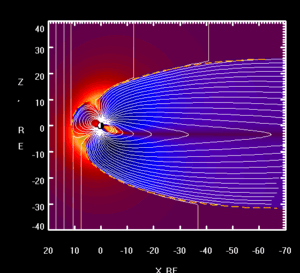
19.7.1 Rapid-Decay Theory
This hypothesis was developed by Thomas G. Barnes, who was “Creation Research Society” president in the mid 1970s. Taking the assumption that the Earth’s magnetic field decayed exponentially, and ignoring evidence of it fluctuating over time, he estimated that “the life of the earth’s magnetic field should be reckoned in thousands, not millions or billions, of years.” It has drawn harsh criticism from both scientists and some creationists.
It has long been observed that Earth’s magnetic field gradually changes over time. Much of this change is due to movement of the magnet poles, and changes in the Earth’s non-dipole field. The earth’s magnetic field strength was measured by Carl Friedrich Gauss in 1835 and has been repeatedly measured since then, showing a relative decay of about 5% over the last 150 years.
While the details of the creationists’ arguments have changed, in essence the argument is that if the Earth’s dipole changes by 5% per century, the Earth can’t be much older than 20 centuries.
One proposal is based on the assumption that Earth was created from pure water with all of the molecules’ spins aligned creating a substantial magnetic field. However spin relaxation times, which measure the time nuclear
magnetisations take to return to the equilibrium, are typically measured in the range of milliseconds or seconds.
Such ideas are inconsistent with the basic physics of magnetism. While short term variations have been shown to be due to a variety of factors, the long-term (million year) variation in field intensity (and even reversal in polarity) are modelled as due to changes in electric currents in the liquid core of the Earth.
19.7.2 Radioisotopes and the Age of the Earth project
“Radioisotopes and the Age of the Earth” (R.A.T.E.) is a joint project by the “Institute for Creation Research” and the “Creation Research Society” to produce experimental geochronological results that support a Young Earth creationist view that the age of the Earth is only thousands of years —not billions, as the scientific consensus has concluded.
Creationists involved in the R.A.T.E. Project point to experiments they have performed, which they claim demonstrate that 1.5 billion years of nuclear decay took place over a short period of time, from which they infer that “billion-fold speed-ups of nuclear decay” have occurred, a massive violation of the principle that radioisotope decay rates are constant, a core principle underlying nuclear physics generally, and radiometric dating in particular.
The scientific community points to numerous flaws in these experiments, to the fact that their results have not been accepted for publication by any peer-reviewed scientific journal, and to the fact that the creationist scientists conducting them were untrained in experimental geochronology.
19.7.3 Radiohaloes
Robert V. Gentry studied these halos and concluded that the rock must have formed within three minutes if the halo was formed by Po-218. This is taken by some creationists as evidence that the earth was formed instantaneously. Other creationists, including some fellow Seventh Day Adventists, have disparaged his work, and have “accused him of wilfully ignoring pertinent evidence and of inconsistently and arbitrarily assuming non-uniform decay rates for all radioactive isotopes except polonium.”
Critics of Gentry from within the scientific community have pointed out that Po-218 is a decay product of radon, which as a gas can be given off by a grain of uranium in one part of the rock and collected in another part of the rock to form a uraniumless halo. Gentry’s examples rely on a radon ring that is close to the Po-210 ring and it is a bit difficult to tell them apart, and it is not certain whether the rings can be positively associated with polonium. Gentry’s work has been continued and expanded by the creationist R.A.T.E. project that was operating between 1997 and 2005.

